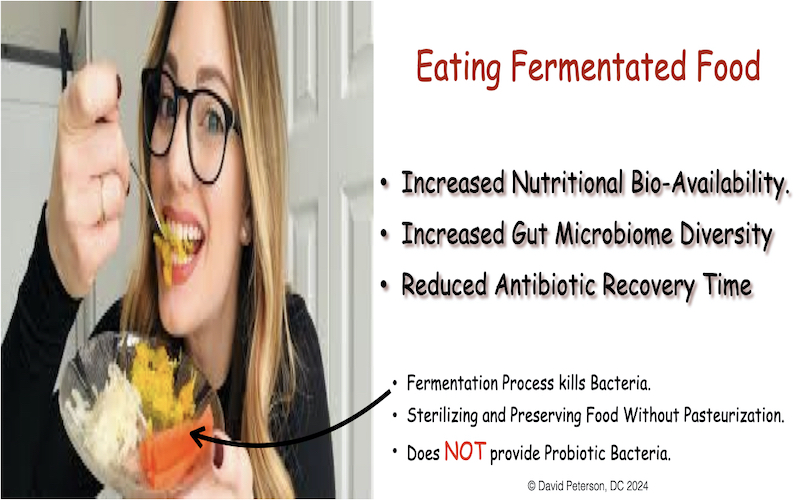Fermented foods have been a staple in various cultures for centuries, offering a range of health benefits that are often superior to those provided by probiotic supplements. This article delves into the unique advantages of incorporating fermented foods into your diet, focusing on aspects such as enhanced digestion, nutrient density, reduction of pathogens, microbial diversity, and the presence of beneficial bioactive compounds.
Antibiotic Recovery:
Probiotics are widely prescribed for prevention of antibiotics-associated dysbiosis and general health. effects. Researchers have found that taking probiotics after antibiotics in fact delays gut health recovery.1Suez et al., 2018, Cell 174, 1406–1423 September 6, 2018 2Freedman SB, Williamson-Urquhart S, Farion KJ, Gouin S, Willan AR, Poonai N, Hurley K, Sherman PM, Finkelstein Y, Lee BE, Pang XL, Chui L, Schnadower D, Xie J, Gorelick M, Schuh S; PERC PROGUT Trial Group. Multicenter Trial of a Combination Probiotic for Children with Gastroenteritis. N Engl J Med. 2018 Nov 22;379(21):2015-2026. 3Dickson I. Probiotics fail to improve preschool gastroenteritis. Nat Rev Gastroenterol Hepatol. 2019 Feb;16(2):76. 4Hempel S, Newberry SJ, Maher AR, Wang Z, Miles JN, Shanman R, Johnsen B, Shekelle PG. Probiotics for the prevention and treatment of antibiotic-associated diarrhea: a systematic review and meta-analysis. JAMA. 2012 May 9;307(18):1959-69. 5Houston S. Eran Elinav: Beyond the microbiome. J Exp Med. 2019 Jan 7;216(1):1-3. 6Suez J, Zmora N, Segal E, Elinav E. The pros, cons, and many unknowns of probiotics. Nat Med. 2019 May;25(5):716-729. 7Su, Grace L. et al. AGA Clinical Practice Guidelines on the Role of Probiotics in the Management of Gastrointestinal Disorders. Gastroenterology, Volume 159, Issue 2, 697 – 705
- When you take antibiotics, they can kill both harmful and beneficial bacteria in your gut, disrupting the balance of your microbiome.
- Many people’s gastrointestinal tracts reject generic probiotics.8Suez J, Zmora N, Zilberman-Schapira G, et. al. Post-Antibiotic Gut Mucosal Microbiome Reconstitution Is Impaired by Probiotics and Improved by Autologous FMT. Cell. 2018 Sep 6;174(6):1406-1423.e16.
- Fermented foods can help speed up recovery by providing nourishment for the remaining beneficial bacteria, helping them to multiply and restore balance more quickly.

Probiotic use after antibiotics delays recovery, increased antibiotic resistance and decreased gut microbiome diversity.
How They Help:
- Feeding Good Bacteria: Fermented foods provide food (prebiotics) for the beneficial bacteria in your gut, helping them recover and grow after antibiotic treatment.
- Supporting Diversity: By promoting the growth of a variety of beneficial bacteria, fermented foods help maintain a diverse and resilient microbiome, which is crucial for good health.


Fermented Food supports rapid Gut microbiome antibiotic recovery.
Conclusion
- In essence, fermented foods help your gut recover faster after antibiotics by providing nourishment for beneficial bacteria. This support helps restore balance in your gut microbiome, promoting better digestion and overall health. Including a variety of fermented foods in your diet can be a natural and effective way to maintain a healthy gut.
Bacterial Content:
- Fermentation Process: Bacteria play a crucial role in fermenting food by converting sugars into acids, gases, or alcohol.
- Post-Fermentation: However, many of these bacteria do not survive the entire process and may not be present in significant amounts by the time the food is consumed. The primary reason for eating fermented foods is for their improved nutrient profile rather than to increase the gut microbiome.

1. Enhanced Digestion
Bacteria and yeast increase the digestibility of food both because they directly consume food components and release their broken down metabolites, and because digestive enzymes can also be released into the food from microbes after they die, further aiding the process of breaking down food, even before it enters your mouth.
Several difficult-to-digest compounds in food, such as lactose and oligosaccharides, can be broken down by fermentation. Lactose-intolerant individuals can therefore often tolerate cultured dairy products (which contain lactose), and IBS patients can sometimes better-tolerate fermented grains (which contain oligosaccharides). Protein, the building block for practically all functions of the human body, can be partially predigested by fermentation, aiding in its absorption. Fats can be freed into non-esterified fatty acids, which improves digestibility.
This is an especially important consideration when digestive function is developing, as in infancy, or compromised due to aging, stress, and illness. A deficiency in digestive function can create a vicious cycle where nutrient absorption is reduced, nutrient status becomes compromised, and the body is even less able to produce digestive enzymes and repair damaged tissue.
In addition, breaking down protein components in food can be important for an individual whose immune system is overactive and prone to developing food sensitivities or even allergies. Those immune reactions occur primarily towards proteins rather than other macronutrients when they aren’t properly digested and in the context of increased gut permeability and other immune stressors.
One example of reduced allergenicity is in fermented milk proteins. Certain lactic acid bacteria can degrade casein and whey, which are the most allergenic proteins in milk, rendering the fermented milk product less allergenic*. The fact that the milk product is also consumed with immunomodulating microbes may also help reduce reactivity.
1.1 Pre-digestion by Bacteria and Yeast
Fermented foods aid digestion even before consumption. The bacteria and yeast involved in fermentation break down food components, making them easier to digest. This process releases digestive enzymes that further aid in breaking down food.
1.2 Improved Digestibility of Difficult Compounds
Fermentation breaks down difficult-to-digest compounds like lactose and oligosaccharides, making these foods tolerable for individuals with lactose intolerance or IBS. Proteins are partially digested, aiding absorption, while fats are freed into non-esterified fatty acids, enhancing their digestibility.
1.3 Importance for Developing and Compromised Digestion
For infants or those with compromised digestion due to aging, stress, or illness, fermented foods can be crucial. They help break the cycle of poor nutrient absorption and compromised digestive function.
1.4 Reduced Allergenicity
Fermentation can reduce food allergenicity by breaking down proteins that trigger immune responses. Fermented milk proteins, for example, become less allergenic as lactic acid bacteria degrade casein and whey.

2. Nutrient Density and Bioavailability
Fermented foods are more nutrient dense than their unfermented counterparts. Not only that, but those nutrients can become more bioavailable (easier to absorb) with fermentation because anti-nutrient levels are reduced.
Take kefir, for example, which is a type of cultured milk with low levels of lactose (since it is broken down by fermentation), high levels of beneficial bacteria and yeasts, and… added nutrients. During fermentation, the broad spectrum of microbes that are found in kefir starters produce additional vitamins including B1, B2, B6, B12, folate and biotin. These B vitamins are essential for myriad metabolic functions, including cellular energy pathways and methylation.
Fermentation reduces anti-nutrients such as phytic acid by up to 40%. Phytic acid is compound found in many grains, legumes, and seeds. Since it can bind essential minerals, such as iron, it reduces their availability for absorption. Breaking down phytic acid by fermentation therefore increases the bioavailability of minerals and helps maintain healthier levels in the body.
2.1 Increased Nutrient Density
Fermented foods are more nutrient-dense than their unfermented counterparts. For instance, kefir is rich in vitamins B1, B2, B6, B12, folate, and biotin, essential for various metabolic functions.
2.2 Reduced Anti-Nutrients
Fermentation reduces anti-nutrients like phytic acid by up to 40%, increasing the bioavailability of minerals such as iron, thereby supporting healthier mineral levels in the body.

3. Pathogen and Toxin Reduction
The addition of protective cultures during fermentation naturally limits the growth of harmful microbes in foods. This effect is related to several factors, including competition for available nutrients, as well as organic acids and bacteriocins produced during the fermentation process. This is why fermentation has traditionally been used to preserve foods from spoilage long before refrigeration.
As an added bonus, fermentation reduces the absorption of potentially-harmful mycotoxins (mold toxins such as aflatoxin B1 and ochratoxin A) that are sometimes found in grain products, likely by partially degrading them to less harmful byproducts.
3.1 Natural Preservation
Fermentation has been used for centuries to preserve foods, limiting the growth of harmful microbes through competition for nutrients and the production of organic acids and bacteriocins.
3.2 Reduction of Mycotoxins
Fermentation reduces the absorption of harmful mycotoxins like aflatoxin B1 and ochratoxin A, often found in grain products, by degrading them into less harmful byproducts.

4. Microbial Diversity
Probiotic foods contain a wide diversity of microorganisms—many more species than are found commercial supplements and including specific therapeutic strains that are sought after in probiotic supplements. When grown on a petri dish, bacteria from probiotic pills colonize in tidy white circles, but dishes plated with fermented foods bloom in “colorful, disorderly splotches.”
4.1 Diverse Microorganisms
Fermented foods contain a wide variety of microorganisms, including specific therapeutic strains not found in commercial supplements. This microbial diversity supports a healthier gut microbiome.

5. Beneficial Bioactive Compounds
As cultured bacteria or yeast consume carbohydrate or protein for their own energy production, they also create byproducts. Of those, the metabolically-active byproducts which we call bioactives, have marked effects on human health that are recognized in scientific literature. Because of the length of time of fermentation, these bioactives are produced in much greater quantities than can be achieved with simple probiotic supplementation alongside meals.
Conjugated linoleic acid, or CLA, is a compound produced from linoleic essential fatty acids. Certain strains of bacteria (those that possess linoleate isomerase—many lactic acid species) produce CLA from linoleic acid, including those used for natural fermentation of pickles. These naturally fermented pickles (not those brined in vinegar) have greater amounts of this super-nutrient than their fresh counterparts. Consumption of CLA has been associated with weight loss, heart health, and blood sugar regulation.
GABA (gamma-aminobutyric acid) acts as a calming neurotransmitter in the body and can be produced endogenously from glutamic acid via the enzyme glutamate decarboxylase.
More bioactives that have been found in fermented foods include compounds that may be able to reduce blood pressure (natural ACE inhibitors), reduce cholesterol, break down blood clots, modulate the immune response, reduce inflammatory cascades, and reduce cholesterol.
5.1 Production of Bioactives
Fermentation produces bioactive compounds that have significant health benefits. These compounds, such as conjugated linoleic acid (CLA) and gamma-aminobutyric acid (GABA), are produced in greater quantities than those from simple probiotic supplementation.
5.2 Health Benefits of Bioactives
CLA, produced in naturally fermented pickles, is associated with weight loss, heart health, and blood sugar regulation. GABA acts as a calming neurotransmitter, while other bioactives can reduce blood pressure, cholesterol, and inflammatory responses.
Conclusion
Incorporating fermented foods into your diet can offer numerous health benefits that go beyond those provided by probiotic supplements. From enhancing digestion and nutrient absorption to reducing pathogens and toxins, fermented foods support overall health and well-being.
References
- 1Suez et al., 2018, Cell 174, 1406–1423 September 6, 2018
- 2Freedman SB, Williamson-Urquhart S, Farion KJ, Gouin S, Willan AR, Poonai N, Hurley K, Sherman PM, Finkelstein Y, Lee BE, Pang XL, Chui L, Schnadower D, Xie J, Gorelick M, Schuh S; PERC PROGUT Trial Group. Multicenter Trial of a Combination Probiotic for Children with Gastroenteritis. N Engl J Med. 2018 Nov 22;379(21):2015-2026.
- 3Dickson I. Probiotics fail to improve preschool gastroenteritis. Nat Rev Gastroenterol Hepatol. 2019 Feb;16(2):76.
- 4Hempel S, Newberry SJ, Maher AR, Wang Z, Miles JN, Shanman R, Johnsen B, Shekelle PG. Probiotics for the prevention and treatment of antibiotic-associated diarrhea: a systematic review and meta-analysis. JAMA. 2012 May 9;307(18):1959-69.
- 5Houston S. Eran Elinav: Beyond the microbiome. J Exp Med. 2019 Jan 7;216(1):1-3.
- 6Suez J, Zmora N, Segal E, Elinav E. The pros, cons, and many unknowns of probiotics. Nat Med. 2019 May;25(5):716-729.
- 7Su, Grace L. et al. AGA Clinical Practice Guidelines on the Role of Probiotics in the Management of Gastrointestinal Disorders. Gastroenterology, Volume 159, Issue 2, 697 – 705
- 8Suez J, Zmora N, Zilberman-Schapira G, et. al. Post-Antibiotic Gut Mucosal Microbiome Reconstitution Is Impaired by Probiotics and Improved by Autologous FMT. Cell. 2018 Sep 6;174(6):1406-1423.e16.



